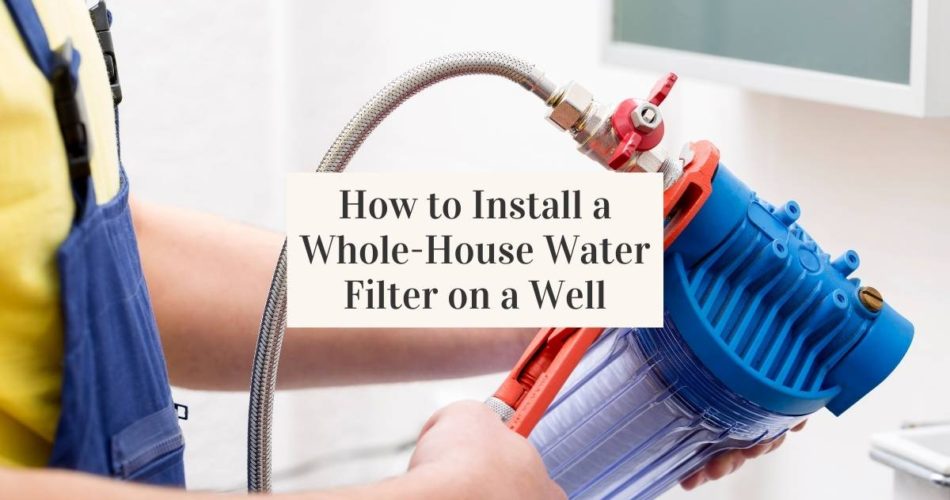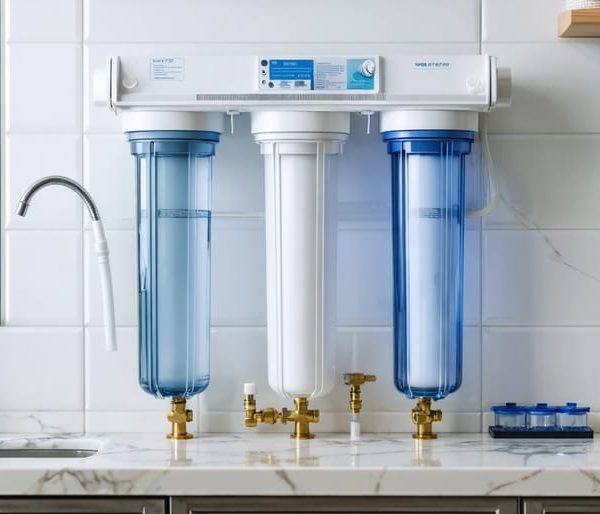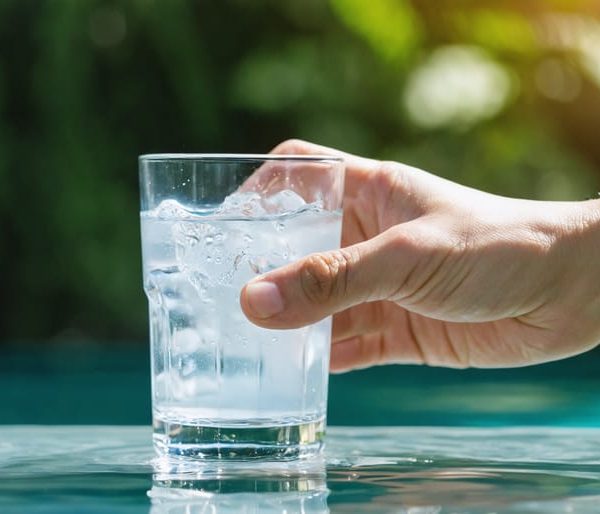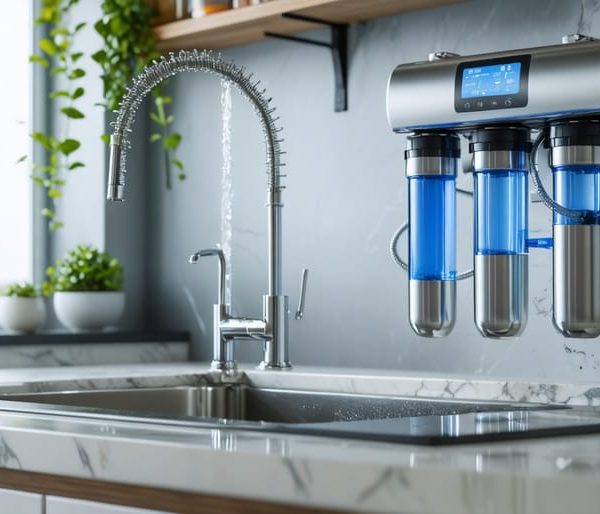To install a whole-house water filter on a well, you need to know about plumbing and fixing. Make sure you have the plumbing layout so you know where to install the filter system.
Selecting Where to Install a Whole House Water Filter
Whole house filter systems are considered point of entry (POE) systems. It means that the water treatment is done at the point of entry into the house. For well water, it is imperative to install it right before the pressure tank. Doing this helps avoid the eventual collapse of the system when debris or sediments build up in case of the absence of bypass valves or prefilters. The goal for most homeowners is to have filtered water at every faucet.
Note that the taps outside your house will be exempted.
The supply line for the water is typically located in the garage, laundry room, basement, or well house in many homes.

When it comes to the waterline, selecting where to place the filter unit depends on whether you also have a water heater or a water softener. Accessibility for inspection and maintenance is also something to think of when choosing a location.
With the Water Heater in Place
Place the filter close to the shut-off valves. The installation should also be near the upstream of your heater. This means that you will need to install the filter unit before the water heater.
Water Softener
When using well water, install the whole house filter after the water softener. This guarantees proper flow during backwashing. This is unless you have already chlorinated your well water. If this is the case, the water softener is tasked with removing the chlorine and is placed before the whole house filter.
Wherever you decide to install your filter system, ensure there is enough clearance under the filtration system. This will be necessary to facilitate the easy removal and reattachment of the cartridge.
Materials and Tools for Installing a Whole-House Water Filter on a Well
Here are some of the materials and tools you will need to install a whole house water filtration system.
Materials
- Whole house water filter
- Fittings
- Tubing
- Shut off valves
- Mounting brackets
- Bypass valves
Tools
- Teflon tape
- Adjustable wrench
- Pipe cutter/mini cutter.
- Bucket
Checking if the Installation Requirements Fit Your Home
Check the throughput, flow rate, and condition of your plumbing. Careful consideration has to be taken on installation when a water heater or a prefilter is in place. Check the flow rate on the instruction manual to ensure it is in line with the recommended rate. You may have to install a pressure control valve. This will ensure that your water comes into contact with the active filters in the system.
Whole-House Water Filter Installation Process
We advise that you follow the local plumbing guidelines or professional contractors.
Draining the Pipes
The first step involves turning off the power supply to the well pump. Shut off the main valve that controls the entry of well water into the house. You need to open all faucets and fixtures to drain all pipes. This will relieve the system of any air and water, which may lead to leaks. The water pressure is released as water is emptied.
Another option is to open the faucet at the lowest point in your home after shutting the main valve. Most of the water in the system will be drained from here.
Cutting the Pipe
The prerequisite to this step is:
- Select the location for installation.
- Having all the proper tools
- Draining the pipes to release the water and air pressure.
Before you start to cut the pipe, have a bucket ready to catch any water from the pipe.
Mark the points where you need to make the cuts on the pipes. Use the pipe cutter and make your cuts on the two points marked. The twist handle will enable you to get a firm grip along the marked lines. Continue twisting the handle until the pipes are cut.
If the space you are installing the filter is limited, you can use a mini cutter to work on the pipe. The mini cutter is smaller in size. It is meant to work in narrower spaces and works just like a normal pipe cutter.
After cutting the pipe, you need to remove any burrs. This is achieved by using a reamer blade on the pipe cutter. You can also sand the burrs at both ends. Burrs are found on the inside of the cut pipes. It is also important to deal with the sharp edges on the ends of the pipe.
Go ahead and clean the pipes by removing any debris inside.
Fitting the System
Fitting the house water filter system involves attaching and fixing the filtration system. This step will need dry fittings. The main idea is to fix an inlet that feeds well water into the whole house filter and an outlet that releases clean water.
Ensure all ports are aligned correctly. According to the filter inlet and outlet, the “in” and “out” ports need to be aligned. If the ports and pipes do not lock properly, you can use an adapter to correct this. There is another option of utilizing a mounting bracket.
Most manufacturers give recommendations on how the whole house filter should be installed. A typical installation will involve positioning the compression nut on the end of one side of the cut pipes. Do the same for the opposite side. Care should be taken to insert the small end first when positioning your compression nut.
Add Teflon tape to the threaded ends. It acts as a sealant that will prevent any leakages between the filter port and fitting. Attach the fitting for the “in” and “out” ports to the filter heads on the filter housing.
Care should be taken with plastic fittings not to exert a lot of pressure when tightening. Push the fitting and soldering to ensure that the fitting is secure. Soldering should not be done near plastic. If you decide to solder, ensure the concerned area is clean.
Positioning the Water Filter System
A majority of water systems come with the filter housing. It is necessary to clean these housing with warm water to remove any sediments after filter installation.
We insist that the alignment of the inlet and outlet for the filter be proper. If you have a meter, the inlet port should be close to the meter. The outlet should be directed towards the water heater.
If the positioning of the ports is not correct, the filter will not work properly.
Once you position the water filter correctly, keep an eye on the clearance below. Go ahead and secure the compression nuts on either side of the pipe. Tightening can be done by hand.
Tighten the rest of the fitting in place using the adjustable wrench.
Let the Water Flow
Remember to close all the open faucets. Before the well water gets to the whole house water filter system, an inlet valve has to be turned. Some of the common positions you will find in most filters include the “off position.” In this state, the filter is not working, and no water comes in via the inlet.
The “Bypass position” allows water to pass through the filters without any filtering.
The “filter position” will activate the filter system to actively filter the water through the inlet and supply your house with clean water.
After fixing the filter, turn the power on the well pump. You also need to turn on the shutoff valve to allow water flow on the main water line.
Before using the filter, we need to verify that the system is not leaking. On the system, change the state of the valve from the “off position” to the “filter position” slowly, allowing minimal pressure. You will notice the tank filling with water.
Check for any leaks in the system and where the compression nuts are. In case of any leaks, go ahead and tighten the nuts and fittings.
Check for any manufacturer’s instruction on activating the filtration medium of the whole house water filter system.
Your installation may also require additional tasks such as adding jumper cables, adding prefilters, and flushing the entire system.
Adding a Jumper Cable
Adding a jumper cable is critical, especially if there was a ground cable already installed. In some cases, old houses utilize pipes for electrical grounding.
It is essentially a copper wire. It is fixed from one side of the filter to the other. You can use the ground clamping to fix the jumper cable in place.
Sediment Filter
Well water is sourced from the ground. It is common to find sediments and debris in the water. A sediment filter acts as a prefilter. It is therefore common to filter well water for sediments before passing it through the whole house filter.
A sediment prefilter assists in producing clean drinking water. It helps extend the lifespan of the filter system. To ensure that your filtration system is working all the time, install a bypass system that will allow your water to enter the whole house filter without going through the sediment prefilter. The bypass system should always remain shut but open when the system needs maintenance.
The sediment prefilter should always be installed before the pressure tank. If flushable, the sediment takes a huge load off the other filters.
Flushing the Whole House Water Filter
After installing the whole house water filter system, it is important to flush it. Flush for at least 2 minutes to get rid of installation debris, air, and water in the system.
Reducing the Pressure Using a Valve From the Main Water Line
Depending on the pressure level of the water after pumping from the well, a valve may need to be introduced to reduce the pressure.
The reduction in pressure makes it possible to filter the water in the filter system actively. Depending on the ability of your well for water supply, it may be necessary to have the pressure valve in place.
Connecting Your Whole House Water Filter to the Main Water Supply
We recommend that you connect your water filter in line with the water supply. This is unless you do not need to filter the water going to all faucets in the house.
If the whole house water filter comes with a prefilter, install this after the main shutoff valve. It prevents water pressure drops due to clogging that may occur., You can also install a bypass that will route the water away from the filtration system. This will give you time to undertake maintenance on your system while still having access to water.
Time Taken to Install a Whole House Water Filter
Experienced plumbers and handymen should take around 2-3 hrs to install a whole house filtration system.
Filter installation by yourself may take a lot longer, depending on your experience. Also, note that installation times depend on other factors, including:
- Availability of proper tools.
- Whether you are installing other water treatment filters, e.g., sediment filter.
- The complexity of the plumbing in your house.
Challenges to Installing a Whole House Filter
A whole house water filter is a worthy investment. The biggest advantage is the provision of drinking water across your house. Installation of these filtration systems is easy, especially when using experienced professionals.
Challenges still arise when carrying out the installation. Some of the issues you need to watch out for include:
- Watch out for the inlet and outlet ports.
- Completely draining the system before installation of the whole house water filter.
- Getting the correct tools may be a challenge if you decide to take this as a DIY home improvement project. We recommend that you research the type of tools required to install the whole house filter you will purchase.
- Post-installation, the flow rate of your water may decline if the capacity of the filter system is limited.
Tips for Installing a Whole-House Water Filtration System on a Well
To ensure a successful project, especially for the DIY enthusiasts, see some tips below:
- Note that the position of the whole house water filter needs to align correctly to the water supply. If possible, choose a location away from direct sunlight. This will prevent the growth of bacteria when it’s hot.
- The space between the filter housing and the ground needs to be at least 15cm. The space will allow for easy servicing of the filter.
- Install the filter system before the shutoff valve. The same is applied to those who have backflow valves on their system. The water heater should come after water treatment.
- Ensure the inlet, the outlet, and the capacity of your whole house water filter is sufficient. When small, these properties will lead to a reduced water flow rate. It is better to replace your plumbing with a larger pipe.
- Cut off the water supply before any installation. Drain the water in the pipes as well. After finishing the installation, flush the entire system to clear all debris and sediments from the installation process.
- Activate the filter media after flushing the system
- We recommend adequate support for fittings and fixes. The weight of the water and the whole house water filter is huge. Proper fixes will prevent your water treatment system from falling off or sagging.
- It is advisable to install the sediment prefilter before the whole house water filter. The effect is that the whole system lasts longer.
- For old houses, take extra care because the pipe might act as a grounding element. String a jumper cable from one side of the filter to the other to maintain the connection on the pipe.
Our Final Thoughts
Whole house filtration systems involve installing filters that clean your well water and supply it throughout the whole house. To install the system, purchase your system, ready the tools and all other prerequisite materials, and you can start. Follow the steps and instructions provided above. Take care when you install your system after the pressure tank but before the water heaters.



